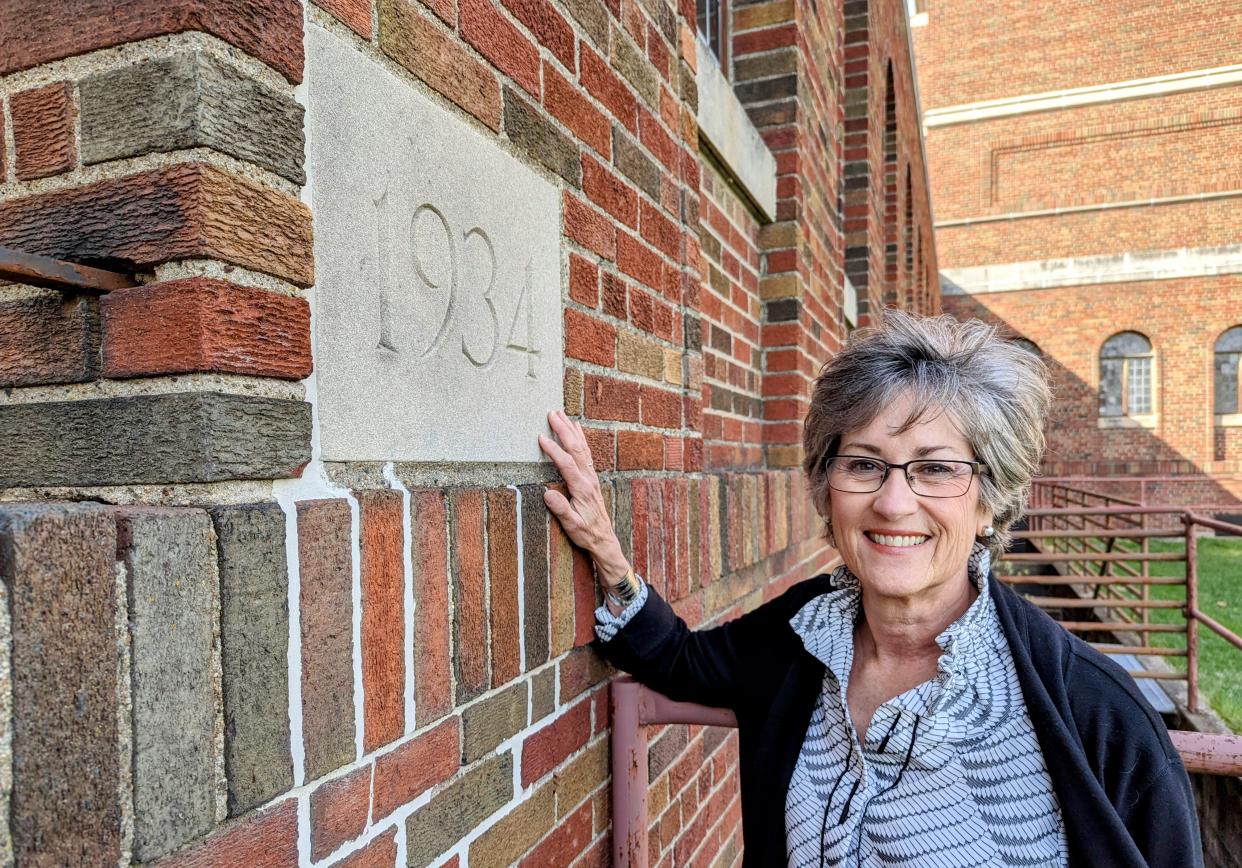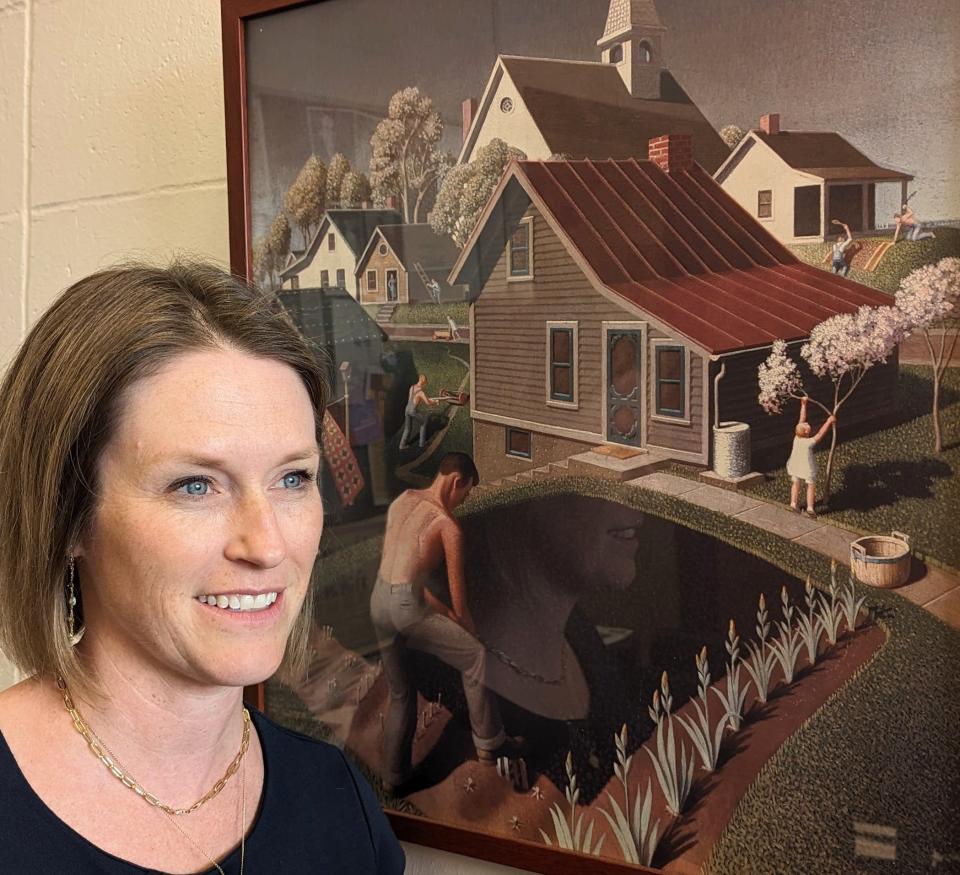’Missing pages’ pursuit one of many projects of Grant Wood Art Colony

- Oops!Something went wrong.Please try again later.
Thirty-seven years ago this week, Geraldo Rivera hosted a hugely publicized opening of what was hyped as a secret Al Capone treasure vault in Chicago.
To Rivera’s embarrassment, the two-hour live TV event earned fame as a bust that uncovered virtually nothing.
The Grant Wood Art Colony (GWAC) of Iowa City has high hopes that the eventual opening of an 89-year-old University of Iowa cornerstone/time capsule at its original Art Building will have better results.
“We don’t want another Geraldo Rivera moment,” quipped GWAC Director Maura Pilcher.
She was joking of course. Yet Pilcher and other Grant Wood historians anticipate that the UI capsule may contain missing pages of a document detailing a key conflict between Wood and other faculty members.
Pilcher explains that Wood’s eight years on the UI faculty from 1934 to his death in 1942 were tumultuous.
More: Grant Wood museum exhibit draws vaccinated seniors from their ‘pandemic hibernation’
“American Gothic” had given the Iowa-grown artist national rock star status with the public. Yet his university peers and others – possibly spurred by jealousy – were known to criticize his work and question his sexual orientation. Some critics even compared his artistic style to that promoted by Hitler’s Nazis.
“We are so excited that the University has now embraced him, since he was snubbed by academic art publications for about 75 years,” Pilcher said.
Joni Kinsey, a professor in the UI School of Art and Art History and member of the GWAC’s National Advisory Board, has researched the topic and examined a copy of the 1934 cornerstone document at the university library. It is untitled and the source is unknown, she said.
The opening paragraph references a conflict between UI art faculty members aligned to the traditional, academic mode of the 19th century versus the more modern artistic style promoted by Wood which challenged the status quo. It hints that the purpose of placing the document within the cornerstone/time capsule is to allow future historians to interpret the conflict “with perspective.”
“But this copy of the document ends abruptly just as the conflict is being described,” said Kinsey. “The final pages are obviously missing.”
The cornerstone engraved with “1934” is still embedded within the outer walls of the original Art Building near the river, now often referred to as the Old Art Building. The structure has been mothballed and unused since the flood of 2008. University officials indicate planning is in the works for its renovation when funds allow, at which time the cornerstone could be accessed and opened.
More: Grant Wood’s cane finds a home in Iowa City house he loved
Kinsey says she “has been on a mission for years” to get the cornerstone opened for examination and thinks “the time is now.” She anticipates the documents and contents are sealed in a metal box, but still fears for their ability to survive nearly nine decades. She has taught American art history at the University for 32 years and plans to retire next year.
“My grandfather once helped open a cornerstone of an old Oklahoma school to celebrate its 75th anniversary,” she lamented. “The contents were mush.”
For Pilcher and the GWAC, helping to research, document and promote the legacy of Grant Wood through various activities is important work.

“He was an educator in spite of not having an advanced degree,” she said. “As a nationally famous artist, he gathered interesting peopled to Iowa City, which is what we do today.”
Kinsey is also pushing for the historic building by the river to be renamed The Grant Wood Building.
“As Iowa's and the University of Iowa's most famous artist, he deserves that kind of visible, public acknowledgement,” she said.
Following are brief recaps of a few current projects of GWAC, which operates from five renovated houses surrounding the historic Grant Wood home on East Court Street in Iowa City. That home is the residence of colony benefactor Jim Hayes, also a Grant Wood historian and chairman of the GWAC board.
Grant Wood Catalogue Raisonné
Pilcher says the GWAC will soon hire a project manager for developing a systematic annotated catalog, known as a catalogue raisonné, of Wood’s art. This will be a long-term effort to create an illustrated record of every piece, including materials, dimensions, titles, dates, exhibition history and provenance. The raisonné is expected to operate on a $1.5 million budget over five years and compile information on hundreds of works by the artist.
“Tracking down all of his work is a huge project,” said Pilcher. “Wood did so much. Projects for friends, using different media, changing styles. There are even some pieces in museums which are attributed to him that are not his.”
GWAC Fellows exhibit
Grant Wood Fellows Johanna Winters and Michael Dixon are now presenting their work during a two-person show at the Drewelowe Gallery, located on the ground floor of the University of Iowa’s Visual Arts Building. The exhibit is free and open to the public daily through April 29.
More: UI art colony helps spread the good news of Grant Wood
Dixon’s paintings, collectively displayed under the title, “Miscegenation Nation,” explore the story of his white mother Peggy amidst the fear of racial mixing in America. Winters presents a combination of videos, sculptural props, and collagraph prints titled “HOWW TO WAYT.”
Each year, GWAC provides three fellowships in painting and drawing, printmaking, and interdisciplinary performance. Fellows are housed at the colony campus, paid salaries, teach courses, engage Iowans, and pursue their artistic endeavors. Pilcher says hundreds of artists from around the world apply for these fellowships each year.
City High senior wins GWAC prize
Charlotte Littlemoon, a senior at Iowa City High, was one of three talented young Iowa artists selected for this year’s Grant Wood Legacy Prize. Judges reviewed more than 400 visual arts entries from Iowa students in media categories Grant Wood worked on: jewelry, painting, drawing and illustration, printmaking, design, ceramics and glass, and mixed media. Littlemoon’s work in the printmaking category is titled “No More Stolen Sisters.”
This article originally appeared on Iowa City Press-Citizen: ’Missing pages’ pursuit one of many projects of Grant Wood Art Colony

